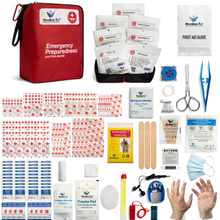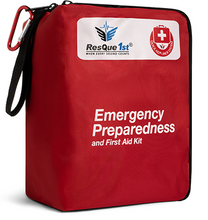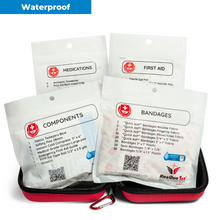
Life has a funny way of throwing unexpected things at us. How we handle the unexpected often comes down to our preparedness and our ability to respond. This has always been the driving force behind the concept of a first-aid kit.
But it’s not just about having a first aid kit in general. It’s about choosing the best first aid kit to suit your needs and circumstances.
Because having the right first aid can save lives.
My First Aid Kit Could Save Lives? Really?
Absolutely! We are not being dramatic here. A large number of accident-related fatalities are a direct result of a lack of first aid treatment in the crucial first ‘golden hour’. Dealing quickly with a cut, laceration, open wound or allergic reaction can save a life. Helping an accident victim who is in shock is absolutely essential, because shock can be deadly.
You never know how serious a problem may be and how important your quick and simple treatment can be. You never know if a victim has more serious underlying health issues.
Then what about floods, a wildfire, a hurricane or a tornado? Are you ready?
Not All Kits Are Equal
Do you have the right kind of kit available when you really need it? Different kinds of problems and injuries can arise in different settings and environments – at home, at work, camping, hunting, road trips, cycling, and so on. The right supplies can make all the difference for treating injuries and cleaning and dressing wounds immediately, as opposed to waiting for help to arrive or traveling to a hospital.
Then there are kits that are for both first aid and emergency preparedness.
Your choice of first aid kit can save a life.
- First Aid Kit. Be prepared to handle cuts, burns, open wounds, strains, sprains, and more. Have what you need to keep someone calm and immobilized should they suffer fractures.
- Trauma Kit. Stop more extensive bleeding with a tourniquet and an advanced QuikClot clotting sponge. Protect your own life by using the kit’s medical gloves.
- Emergency Kit. Prepared people keep one ready in their back yards. In addition to first aid items, it should be packed with what you need to survive a short time in difficult circumstances like cold, in the wild, after an earthquake, and so on.
By the way, add a CPR mask with one-way valve to every kit. This is definitely a life saver. Sometimes, mouth-to-mouth resuscitation can be difficult, or the rescuer needs to avoid fluid transfer from the victim. A pocket-sized shield with a valve can be inserted into any kit.
Does Your Kit Include a First Aid Guide?
You don’t have to be a first aid expert to save a life. If your kit includes a guide, anyone can provide crucial treatment.
Thinking Ahead
Your first aid kit must be appropriate for the activities going on around you and the length of time they last. For example, if you’re camping for a week, you need more supplies than just for a day hike.
Also think how many people need to be covered by a kit. A good kit will tell you how many people it’s good for.
Extra supplies can mean the difference between life and death. The wrong kit will leave you short.
Keep it Fresh, Keep it Stocked
Supplies simply must be replaced and kept within their shelf life. Otherwise, a kit becomes useless. It's easy to get a kit and forget about it. Some first aid items expire or deteriorate.
Mark your calendar the same as you do for smoke detectors to check supplies twice a year. And if you ever use some supplies, replace them immediately.
Creative Commons Attribution: Permission is granted to repost this article in its entirety with credit to First Aid Shoppe and a clickable link back to this page.









